Teachers Matter—Improving Recruitment, Retention and Development of Teachers
A special issue of Education Sciences (ISSN 2227-7102). This special issue belongs to the section "Teacher Education".
Deadline for manuscript submissions: closed (30 April 2021) | Viewed by 81069
Special Issue Editors
Interests: teacher supply; teacher development; teacher effectiveness; education policy; parental involvement; critical thinking; arts education; evaluation of education programmes; research methods
Special Issues, Collections and Topics in MDPI journals
Interests: education and social policy; teaching and teacher education; social justice; assessment; literacy; widening participation; vocational education; evidence use in education; research methods
Special Issue Information
Dear Colleagues,
Teachers are important, but never more so than now when schools all over the world are closed due to the recent global coronavirus pandemic. To ensure that their students’ learning continues despite the school closure, teachers have turned to technology and other creative ways of delivering education. But technology is no substitute for face-to-face interactions. What this pandemic has taught us is that we need not only more teachers, but teachers who are resourceful, effective, and caring. For years, many countries have reported a widespread shortage of teachers, with the problem predicted to get worse as the pupil population in some areas increases. This is an urgent problem which requires attention and investment from policymakers. For this Special Issue of Education Sciences, we invite papers related to issues concerning teacher recruitment and retention, teacher development, teacher preparation, and teacher quality for all phases of education, from early childhood through to higher education. We particularly welcome original empirical research using robust designs and methodology as well as high-quality reviews including meta-analyses, scoping studies, and rapid reviews.
Dr. Beng Huat See
Dr Rebecca Morris
Guest Editors
Manuscript Submission Information
Manuscripts should be submitted online at www.mdpi.com by registering and logging in to this website. Once you are registered, click here to go to the submission form. Manuscripts can be submitted until the deadline. All submissions that pass pre-check are peer-reviewed. Accepted papers will be published continuously in the journal (as soon as accepted) and will be listed together on the special issue website. Research articles, review articles as well as short communications are invited. For planned papers, a title and short abstract (about 100 words) can be sent to the Editorial Office for announcement on this website.
Submitted manuscripts should not have been published previously, nor be under consideration for publication elsewhere (except conference proceedings papers). All manuscripts are thoroughly refereed through a double-blind peer-review process. A guide for authors and other relevant information for submission of manuscripts is available on the Instructions for Authors page. Education Sciences is an international peer-reviewed open access monthly journal published by MDPI.
Please visit the Instructions for Authors page before submitting a manuscript. The Article Processing Charge (APC) for publication in this open access journal is 1800 CHF (Swiss Francs). Submitted papers should be well formatted and use good English. Authors may use MDPI's English editing service prior to publication or during author revisions.
Keywords
- teacher recruitment
- teacher retention
- teacher preparation
- teacher effectiveness







